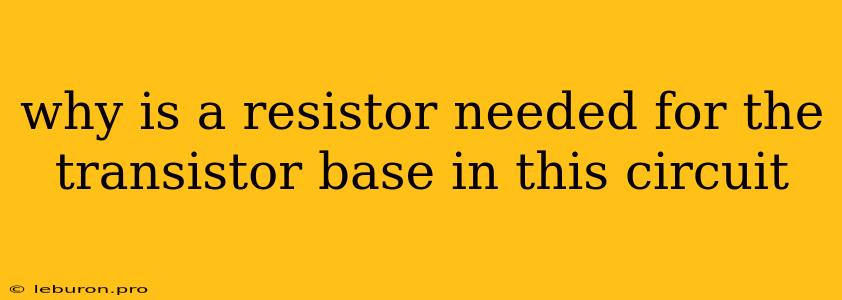Transistors are fundamental components in electronics, acting as switches or amplifiers. They consist of three terminals: the base, collector, and emitter. The base plays a crucial role in controlling the flow of current between the collector and emitter. One common question arises: why is a resistor needed for the transistor base in certain circuits? This article explores the essential function of the base resistor and its impact on transistor operation.
The Role of the Base Resistor
A base resistor is often employed in transistor circuits to limit the base current and prevent damage to the transistor. The transistor's base-emitter junction acts like a diode, allowing current to flow in one direction only. When a small amount of current is applied to the base, it amplifies the current flowing between the collector and emitter. However, excessive base current can lead to overheating and potentially destroy the transistor. The base resistor acts as a current-limiting device, preventing this scenario.
Understanding the Base-Emitter Junction
The base-emitter junction is a crucial part of a transistor's operation. It acts as a diode, allowing current to flow in one direction only. When a small amount of current flows through the base-emitter junction, it allows a much larger current to flow between the collector and emitter. This amplification effect is the core functionality of the transistor.
The Importance of Current Limiting
The base resistor is essential because it limits the current flowing into the base. If the base current is not limited, it can easily exceed the transistor's maximum rating. When this happens, the transistor will overheat and potentially be damaged. This damage can be irreversible, rendering the transistor unusable.
Controlling Base Current
The value of the base resistor is crucial for controlling the base current. A higher resistance value limits the current flow to a lower value, while a lower resistance value allows more current to flow. The specific value of the resistor is determined by the desired operating point for the transistor, which is influenced by factors like the transistor's gain, the supply voltage, and the intended application of the circuit.
Why is a resistor needed for the transistor base in this circuit?
The need for a base resistor depends entirely on the specific circuit configuration. Here are some common scenarios where a base resistor is essential:
1. Protection against Excessive Base Current:
In many circuits, the base current needs to be limited to prevent damage to the transistor. The resistor acts as a current limiter, ensuring that the base current stays below the transistor's maximum rating.
2. Setting the Operating Point:
The base current affects the transistor's operating point, determining the collector current and voltage. By adjusting the base resistor, we can control the operating point to achieve the desired performance in the circuit.
3. Biasing the Transistor:
Transistors require a specific bias condition to operate correctly. The base resistor helps establish this bias by providing a controlled current path to the base-emitter junction. This ensures that the transistor is in the active region, where it can amplify signals effectively.
4. Achieving Stability:
Without a base resistor, fluctuations in the base current can lead to instability in the circuit. The base resistor helps stabilize the operating point by providing a predictable current path and preventing sudden changes in the base current.
Practical Considerations
When choosing a base resistor, several factors need to be considered:
1. Transistor Specifications:
The transistor's datasheet provides information on its maximum base current and gain. The resistor value should be chosen to limit the base current to below this maximum rating.
2. Circuit Requirements:
The circuit's intended functionality and operating conditions will influence the choice of resistor value. For example, a higher base current might be needed for a high-power amplifier, while a lower base current might be suitable for a low-power switch.
3. Supply Voltage:
The supply voltage affects the voltage drop across the base resistor. The resistor value needs to be selected to ensure that the base-emitter voltage is within the transistor's specifications.
Conclusion
The base resistor is an essential component in many transistor circuits, playing a critical role in limiting base current, setting the operating point, and ensuring stability. By understanding the function of the base resistor and its importance in circuit design, we can build reliable and efficient circuits utilizing transistors.
The base resistor is not always necessary, but when it is, it plays a crucial role in protecting the transistor, controlling the operating point, and ensuring circuit stability. This knowledge is essential for anyone working with transistors and designing electronic circuits.
